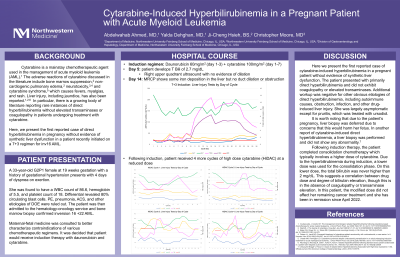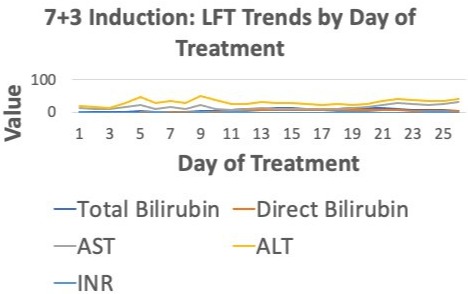Back


Poster Session B - Monday Morning
Category: Liver
B0560 - Cytarabine-Induced Hyperbilirubinemia in a Pregnant Patient With Acute Myeloid Leukemia
Monday, October 24, 2022
10:00 AM – 12:00 PM ET
Location: Crown Ballroom

Has Audio

Yalda Dehghan, MD
Northwestern Memorial Hospital
Chicago, IL
Presenting Author(s)
Abdelwahab Ahmed, MD, Yalda Dehghan, MD, Ji-Cheng Hsieh, MD, Christopher Moore, MD
Northwestern Memorial Hospital, Chicago, IL
Introduction: We present a case of a 33-year-old pregnant patient with inversion 16 Acute Myeloid Leukemia (AML) that developed cytarabine-induced hyperbilirubinemia without other signs of synthetic liver dysfunction.
Case Description/Methods: A 33-year-old patient, G2P1, at 19 weeks gestation with a medical history of gestational hypertension presents with a chief complaint of dyspnea on exertion over the past four days. In the emergency department, laboratory findings were notable for a white blood cell count of 86.6, hemoglobin of 5.5, and a platelet count of 18. Bone marrow biopsy was performed and confirmed the diagnosis of inversion 16, +22 AML.
Once on the hematology service, maternal fetal medicine (MFM) was consulted for assistance regarding contraindications to chemotherapy. A chemotherapeutic regimen consisting of daunorubicin 60mg/m2 and cytarabine 100 mg/m2 was chosen. On Day 5 of treatment, the patient’s total bilirubin was above 2 mg/dL for the first time and coincided with the development of jaundice. This prompted a right upper quadrant ultrasound that revealed mild non-obstructive cholestasis. The total and direct bilirubin continued to rise to a peak of 13.4 mg/dL and 8.5 mg/dL, respectively, on Day 14 (Figure 1). There were no associated rises in INR.
Total and direct bilirubin continued to downtrend until discharge on day 32, after adequate recovery of neutrophils (Absolute neutrophil count > 1000) and platelets.
The patient received four more maintenance cycles of high dose cyatarbine (HiDAC) at a reduced dose in the setting of hyperbilirubinemia during the induction phase. Mild elevations in total and direct bilirubin that normalized after each cycle were observed. Most recent bone marrow biopsy after maintenance cycles revealed no evidence of disease.
Discussion: In this report, a pregnant patient exhibited cytarabine induced isolated hyperbilirubinemia during induction chemotherapy without any other evidence of liver dysfunction; in addition, decreasing cytarabine dosage during the consolidation phase resulted in lower elevations of bilirubin. Our findings add to the existing literature on cytarabine induced hyperbilirubinemia by highlighting its effects in pregnancy, while also showing that dose adjustments can be utilized not only to prevent high bilirubin levels but to achieve clinically significant outcomes.

Disclosures:
Abdelwahab Ahmed, MD, Yalda Dehghan, MD, Ji-Cheng Hsieh, MD, Christopher Moore, MD. B0560 - Cytarabine-Induced Hyperbilirubinemia in a Pregnant Patient With Acute Myeloid Leukemia, ACG 2022 Annual Scientific Meeting Abstracts. Charlotte, NC: American College of Gastroenterology.
Northwestern Memorial Hospital, Chicago, IL
Introduction: We present a case of a 33-year-old pregnant patient with inversion 16 Acute Myeloid Leukemia (AML) that developed cytarabine-induced hyperbilirubinemia without other signs of synthetic liver dysfunction.
Case Description/Methods: A 33-year-old patient, G2P1, at 19 weeks gestation with a medical history of gestational hypertension presents with a chief complaint of dyspnea on exertion over the past four days. In the emergency department, laboratory findings were notable for a white blood cell count of 86.6, hemoglobin of 5.5, and a platelet count of 18. Bone marrow biopsy was performed and confirmed the diagnosis of inversion 16, +22 AML.
Once on the hematology service, maternal fetal medicine (MFM) was consulted for assistance regarding contraindications to chemotherapy. A chemotherapeutic regimen consisting of daunorubicin 60mg/m2 and cytarabine 100 mg/m2 was chosen. On Day 5 of treatment, the patient’s total bilirubin was above 2 mg/dL for the first time and coincided with the development of jaundice. This prompted a right upper quadrant ultrasound that revealed mild non-obstructive cholestasis. The total and direct bilirubin continued to rise to a peak of 13.4 mg/dL and 8.5 mg/dL, respectively, on Day 14 (Figure 1). There were no associated rises in INR.
Total and direct bilirubin continued to downtrend until discharge on day 32, after adequate recovery of neutrophils (Absolute neutrophil count > 1000) and platelets.
The patient received four more maintenance cycles of high dose cyatarbine (HiDAC) at a reduced dose in the setting of hyperbilirubinemia during the induction phase. Mild elevations in total and direct bilirubin that normalized after each cycle were observed. Most recent bone marrow biopsy after maintenance cycles revealed no evidence of disease.
Discussion: In this report, a pregnant patient exhibited cytarabine induced isolated hyperbilirubinemia during induction chemotherapy without any other evidence of liver dysfunction; in addition, decreasing cytarabine dosage during the consolidation phase resulted in lower elevations of bilirubin. Our findings add to the existing literature on cytarabine induced hyperbilirubinemia by highlighting its effects in pregnancy, while also showing that dose adjustments can be utilized not only to prevent high bilirubin levels but to achieve clinically significant outcomes.

Figure: Figure 1. Laboratory trends during chemotherapeutic induction phase with Cytarabine and Daunorubicin. Peak elevation in total and direct bilirubin can be seen on Day 14.
Disclosures:
Abdelwahab Ahmed indicated no relevant financial relationships.
Yalda Dehghan indicated no relevant financial relationships.
Ji-Cheng Hsieh indicated no relevant financial relationships.
Christopher Moore indicated no relevant financial relationships.
Abdelwahab Ahmed, MD, Yalda Dehghan, MD, Ji-Cheng Hsieh, MD, Christopher Moore, MD. B0560 - Cytarabine-Induced Hyperbilirubinemia in a Pregnant Patient With Acute Myeloid Leukemia, ACG 2022 Annual Scientific Meeting Abstracts. Charlotte, NC: American College of Gastroenterology.

